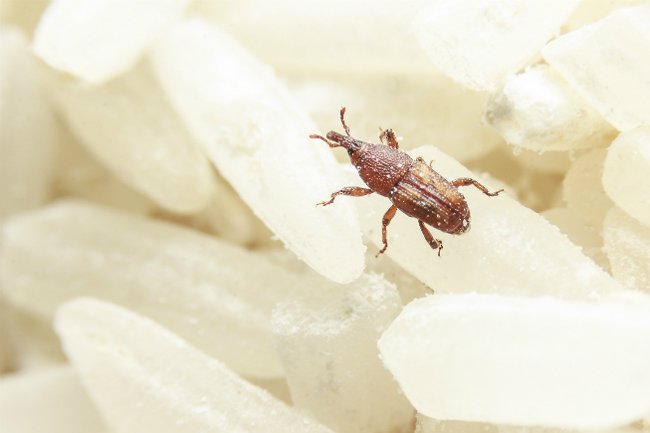

We may earn revenue from the products available on this page and participate in affiliate programs. Learn More ›
No matter how scrupulously you clean your kitchen, you may still open your cabinets one day to find them crawling with tiny bugs. Unlike insects that enter through doors, windows, and crevices, weevils sneak in with your groceries. The adults chew into grains and lay eggs, making it virtually impossible to tell if you’ve purchased a sack of something that contains weevil larvae—that is, until you suddenly discover a slew of weevils in rice or weevils in flour.
What are weevils?
Before learning how to get rid of weevils, it helps to know what, exactly, they are. Weevils are small herbivorous beetles that belong to the Curculionidae family. Also called snout bugs after their elongated snouts, weevils are known for infesting common pantry items like rice, flour, and corn.
What do weevils look like? These pantry pests are quite small, usually between 1/16 and ¼ inch long, so they’re easy to miss. But they can live for up to 8 months as they munch on your pantry staples and lay eggs that look like small white grubs. There are actually thousands of different weevil species, but only a few species are interested in the contents of your pantry.
3 Types of Weevils You Might Find in Your Pantry
Of the some 40,000 weevil species, the ones that threaten your pantry are rice weevils, maize weevils, and granary weevils.
| Type of Weevil | Description |
| Rice Weevils |
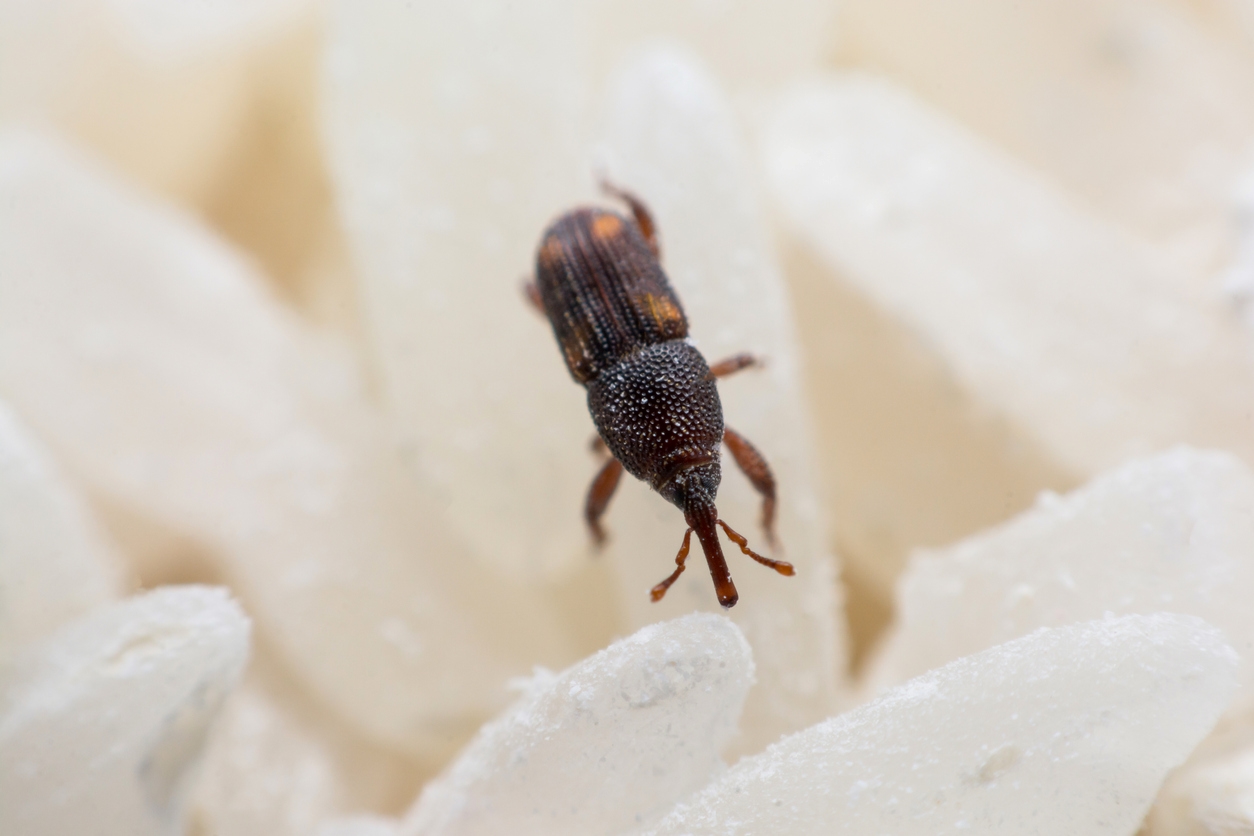
Rice weevils, aka Sitophilus oryzae, are usually about 1/16 to ⅛ inch long. They feed on rice and can lay around 400 eggs during their 5-month life cycle. Because they can fly, infestations can spread quickly. Rice weevils are reddish brown to black and have small round indentations on their thorax as well as red or yellow markings on their wings. Maize Weevils
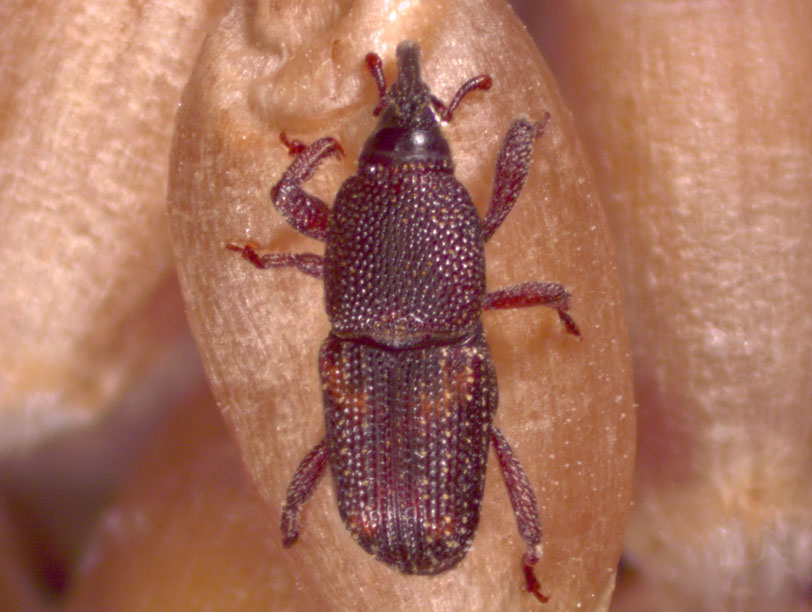
Similar to rice weevils, maize weevils (Sitophilus zeamais) are red-brown to black in color with red or yellow spots on their wings, and they range in size from 1/16 to ⅛ inch long. Their favorite foods are corn, pasta, bread, flour, and beans. Like rice weevils, maize weevils can fly, and they can lay 300 to 400 eggs during their 5- to 8-month lifespan. Granary Weevils
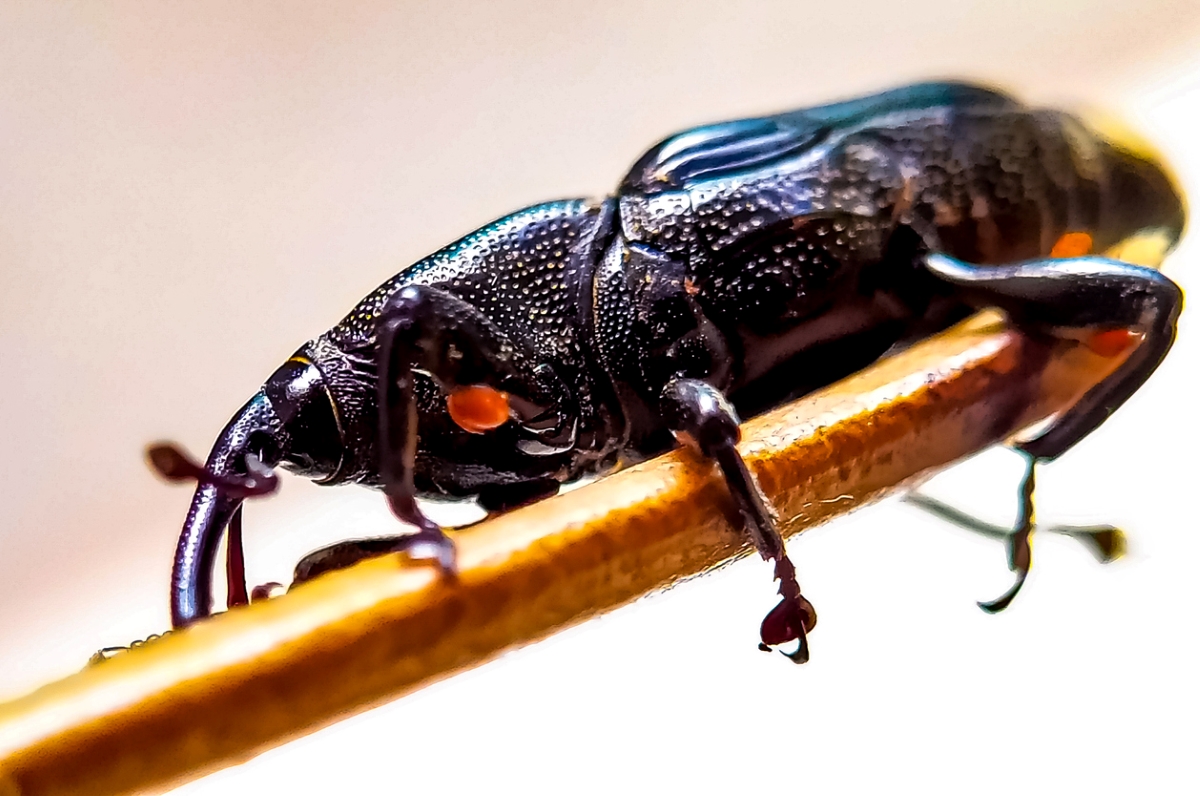
Granary weevils are the largest of these three, usually around ¼ inch long, but unlike maize and rice weevils, granary weevils can’t fly, so they’re easier to contain. Also known as Sitophilus granarius, granary weevils love to feed on whole grains, like cereal and oats. They’re usually black-brown or red-brown in color and lay around 200 eggs in their 8-week life cycle.
Tools & Materials
Bobvila.com may earn a commission from purchases made through these links.
Before You Begin
Finding weevils in food can feel overwhelming—not to mention icky—but fortunately getting rid of them is a straightforward process. Before you begin your pantry purge, don disposable gloves if you don’t want to actually touch any of the pests. The good news is that whether you’re wearing gloves or not, weevils won’t cause you any harm. In fact, even if you accidentally ingest a weevil, you don’t need to worry: According to the Singapore Food Agency, they don’t pose health hazards to humans.
Step 1: Throw out open packages of food.
By the time you spot those dark little bugs in your rice, odds are they’ve infested other nearby food items. To oust them, you have to purge your pantry of any unsealed dry foods, including oats, rice, barley, flour, cornmeal, pasta, and even prepackaged box-type dinners that don’t have sealed internal pouches. Rice weevils often hatch from larvae in sealed bags of rice, so examine all pantry items—even the sealed packages—thoroughly.
Don’t stop there: Weevils can live in cardboard packaging, so if boxed products have sealed airtight bags inside, it’s a good idea to toss the box and keep the bag. (Label the bag with an indelible marker so you’ll know what’s inside.) Do this even for boxed products weevils won’t eat, such as gelatin, because the pests could have entered the box and may emerge later to infest other products.
RELATED: 25 Things to Get Rid of Before 2025
Step 2: Freeze salvageable pantry goods to kill weevil larvae.
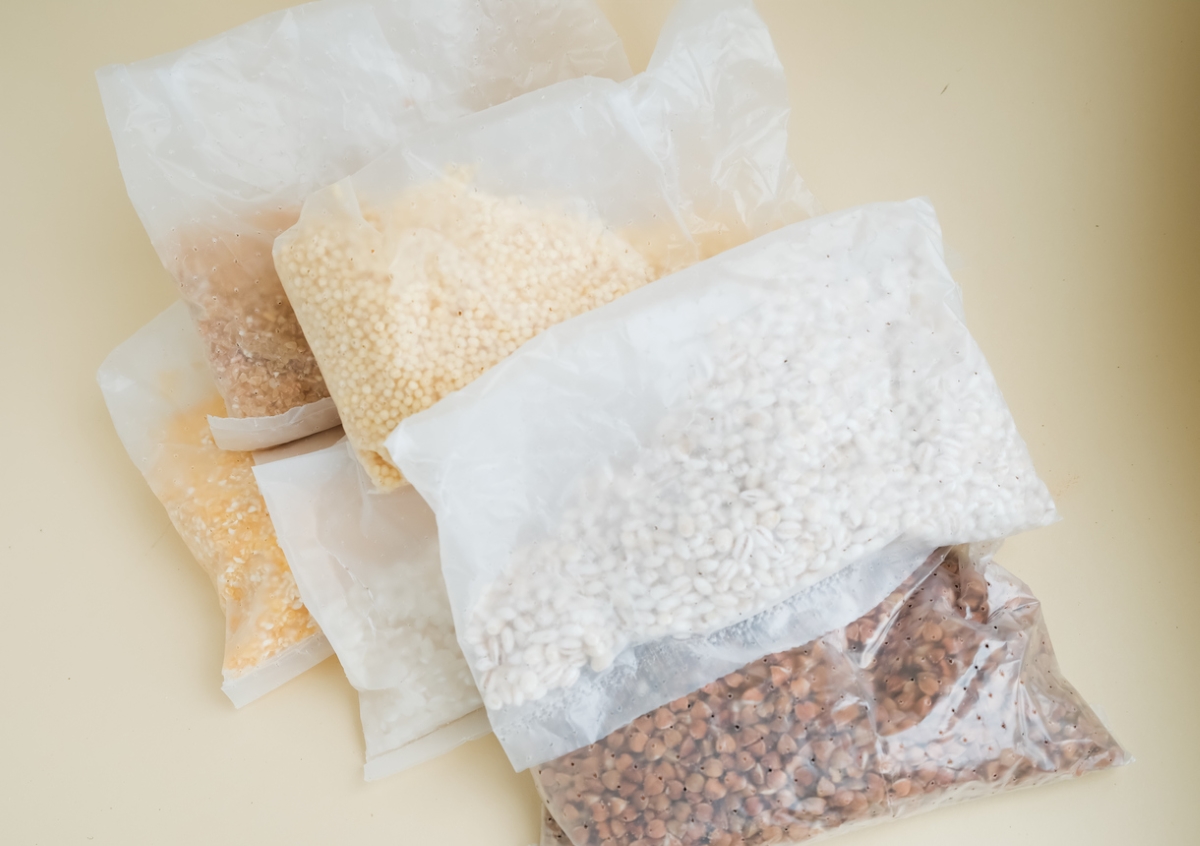
Even sealed pantry goods are subject to weevil infestations. If you’re concerned, you can put these sealed goods in the freezer for 4 to 7 days to kill any weevils and larvae that might be in them. Some items won’t withstand freezing—dried herbs, for instance, may lose their zing—in which case you might just want to toss them. Most of the items weevils feed on, however, do fine in the freezer and can be thawed simply by taking them out. Before returning anything to the shelves, proceed to Step 3.
Step 3: Remove everything from your cabinets and vacuum them out.
Completely empty your pantry shelves. Remove everything—canned goods, spices, aluminum foil, and whatever else you store in your pantry—so you can be certain to get rid of every weevil. Vacuum the shelves, making sure to get into the nooks and crannies, and then take your vacuum outside to dump the canister or bag.
Wipe down the entire vacuum (canister included) with disinfectant before bringing it back inside.
Step 4: Clean the pantry shelves and containers thoroughly.

Wash all shelves and cabinet interiors with a sponge dipped in hot soapy water, white vinegar, or a nontoxic household cleaner, and let dry thoroughly. (Heavy chemicals like bleach or ammonia won’t have any effect on the pests.) Again, concentrate on corners and cracks where weevils might hide.
Likewise, avoid spraying insecticides in cabinets and pantries where you store food. Not only should these chemicals not come in contact with foodstuffs, but many do not work on weevils. Some homeowners use nontoxic enzyme cleaners like Nature’s ERADICATOR, which you can find at home centers and through online retailers.
Next, use the same nontoxic cleanser and method to disinfect the inside and outside of any food storage containers, such as mason jars and reusable plasticware, that may have harbored weevils.
Whichever cleaner you choose, be certain to follow the manufacturer’s safety precautions because some cleaners are toxic. Also, always let the cleaner dry thoroughly before replacing food items in the cabinets.
RELATED: Storage Sanity: 15 Ways to Organize a Pantry
Preventing Future Weevil Infestations

With the four steps outlined above, you can get rid of weevils in an afternoon. Still, before you put anything back in the pantry, inspect your dry goods for weevils, and then give them a good once-over the next time you use them. It might take one or two weevil life cycles to completely rid your pantry of the tiny household pests.
To prevent further infestations, seal and stash dry staples, such as rice, beans, pasta, and cereals, in the freezer for 4 to 7 days after purchase before stowing them in cabinets (or simply store nuts and grains in the freezer if you have space).
If there’s no room in your freezer, keep these staples in sealed glass, metal, or heavy plastic food storage containers. If these suggestions seem like overkill, remember that all it takes is one female weevil to start another invasion.
RELATED: These 13 Pests Do the Most Damage to the Home
Final Thoughts
Weevils can enter your home straight from a grocery shelf, so prevention is the key to managing these grain-eating insects. Carefully inspect packages of nuts, seeds, and grains before purchase or as you unpack groceries purchased online. If you spot weevils in your pantry staples, remove everything from the pantry, inspect all food and packaging, throw out infested foods or freeze them for 4 to 7 days, toss cardboard boxes that might harbor weevils, and then thoroughly clean the cabinets.
Prevent weevils from setting up shop in your pantry by storing the foods they like in the freezer or in sealed glass, metal, or sturdy plastic containers.
FAQs
Read through these common questions to learn more about weevils and how they get into your pantry staples.
Q: What are weevils attracted to?
These tiny beetles like dry foods, such as cereals, grains, seeds, and nuts.. Keep in mind that rice weevils, which are common pantry invaders, enjoy lots of grains beyond rice, including barley, wheat, corn, oats, and rye. Weevils thrive in warm—even hot—conditions, and these high temperatures can speed up their life cycle and cause their numbers to multiply rapidly.
Q: Can weevils get into sealed packages?
Weevils can infest products early in the food chain, such as during harvest or storage. They can also chew through paper and plastic packaging to reach their meals.
Once inside a box, weevils can thrive undetected while working their way through additional plastic or paper barriers. When possible, avoid buying packages with holes or other openings to minimize the risk of bringing the bugs home with you from the grocery store.
Q: What is the lifespan of a weevil?
The lifespan of a weevil—from egg to adult—can last between 5 and 8 months, depending on the type of weevil and its living environment. In that time, a female weevil can produce as many as 400 eggs. She perforates seeds or kernels, lays her eggs in the food, and then seals them with a secretion. Her weevil larvae eat the seed or kernel from the inside out, leaving nothing but a husk.
